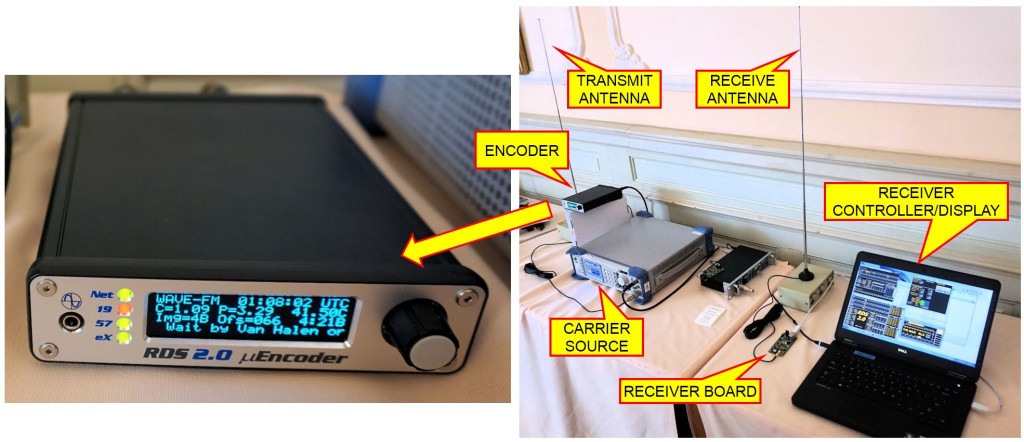RDS2 Demonstrated at 2015 RDS Forum Meeting

For nearly three decades the Radio Data System (RDS) digital FM subcarrier has been providing FM broadcasters the ability to transmit a digital data stream to listeners. Developed in Europe, RDS was slow to take hold in the U.S. at first, but the introduction of digital radio services in the early 2000’s also heralded a significant uptake in the use of RDS to provide song title and artist and traffic-related information to RDS-equipped receivers. It is estimated that there are currently over 5 billion RDS-equipped radios worldwide.
While extremely useful, the RDS signal is severely limited in data capacity, and the RDS Standards (IEC 62106 and NRSC-4-B) include a number of features that have become out-of-date and are no longer needed. Given these factors, the RDS Forum, a European-based standards-development group responsible for the initial development and on-going maintenance of the IEC version of the Standard, agreed at its annual meeting in July 2014 to begin considering an update to RDS that would address these issues. A follow-on meeting to discuss a proposed enhancement called “RDS2” was held in Budapest in November 2014 which resulted in a “feasibility document” describing the proposed RDS2 system.
Last week, the RDS Forum held its 2015 annual meeting, and a prototype RDS2 system was demonstrated. Further, after deliberating the potential benefits afforded by this new system, the RDS Forum created a Working Group with the goal of updating the RDS Standard to include RDS2. A brief description of RDS2 is given here:
- RDS2 offers the ability to transmit one, two or three additional subcarriers along with, and identical in structure to, the legacy RDS subcarrier. While the legacy subcarrier is centered at 57 kHz (within the FM baseband), the three new subcarriers are centered at 66.5, 71.25 and 76 kHz (as with the legacy 57 kHz subcarrier, these new subcarriers are each derivable from the 19 kHz pilot). Shown in the figure below is a spectral plot of the RDS and RDS2 subcarriers and the 19 kHz pilot tone (this plot is from the prototype system demonstrated to the RDS Forum);

- The proposed RDS2 system design was developed by Attilla Ladanyi, T&C Holdings (Germany) and Peter Jako, Hungarian Radio. The demo transmission hardware operated and on display at this year’s Forum was developed by Allen Hartle and Seth Stroh, Jump2Go (USA), and is based upon Jump2Go’s “JumpGate3” platform; the demo reception hardware was developed by Hendrik van der Ploeg, Catena and Joop Beunders, MacBe (Netherlands). A photo of the demo setup is shown below. Note that this was an actual low-power “over-the-air” transmission.
- It is proposed that the new RDS2 subcarriers will be used exclusively to transmit “Open Data Application” (ODA) information. Previously established as part of the legacy RDS format, ODAs are used to support a variety of data services, and are the principal way that new services utilize RDS. Since the new subcarriers will be freed from transmitting the various “overhead” types of RDS data such as the Program Information (PI) and Program Service (PS) codes, the overall data capacity of the RDS2 signal (for “payload”) is on the order of 10 to 20 times (or more) of that available with the legacy RDS subcarrier alone.
A comparison of data capacity is given in the table below, where three cases are compared: Case 0 illustrates the capacity (in effective bit rate) of a legacy RDS subcarrier where 10% of the payload is used for transmitting ODA data (this is a typical scenario in use today); Case 1 again represents a legacy RDS subcarrier but this time with a 70% ODA payload, showing essentially the maximum ODA payload throughput using the legacy RDS signal; and finally, Case 3 shows a 30-fold improvement in ODA payload capacity when all three RDS2 subcarriers are used to carry 100% ODA data (assuming no ODA data on the legacy subcarrier; this is the proposed use case for RDS2). For this table, “STREAM 0” refers to the data stream used to modulate the legacy RDS subcarrier while “STREAMS_1-3” refers to the data streams modulating the three RDS2 subcarriers.
Some of the new applications that are proposed for and would be supportable by RDS2 include the ability to transmit a station logo and the use of the UTF-8 character set to support longer Radio Text and Program Service text strings. Currently, these applications are not supportable with RDS because of the limited capacity of the existing system as illustrated by the cases shown in the above table.
With the completion of the successful prototype demonstration and the RDS Forum members in agreement that RDS2 should be incorporated into the Standard, it is now the task of the newly formed RDS Forum Working Group to develop the detailed specification for RDS2, and in addition to identify the obsolete sections of the existing Standards that can be eliminated. NAB Senior Director, Advanced Engineering David Layer, who participated in this year’s RDS Forum meeting as a liaison for the National Radio Systems Committee (NRSC, co-sponsored by NAB and the Consumer Electronics Association), will be participating in the RDS Forum Working Group, and will work to ensure compatibility of the updated European Standard with the NRSC’s version of the RDS Standard (NRSC-4-B, United States RBDS Standard).
In parallel with the Standards development work, the RDS Forum intends to work on identifying “killer applications” for RDS2, and identifying chip and receiver manufacturer partners interested in developing hardware that will support these upgrades to the RDS system. Outreach is also planned to broadcasters to inform them of this work, and to seek out their input and participation in the Standards-setting and applications development processes.
Visit the RDS Forum and NRSC websites for additional information on these organizations. For additional information on the RDS2 project or to find out how to get involved in this work, email David Layer at NAB.



